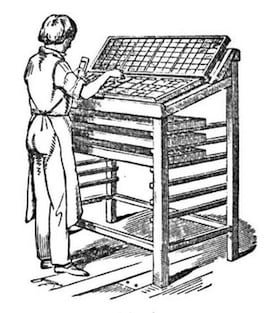Uppercase and Lowercase

Interesting Facts in Easy English
Pre-Listening Vocabulary
- terminology: vocabulary related to a specific subject
- compartment: a division in a larger space; a small section
- case: box
- typesetter: a person who prepares the font and text for printing purposes
- assemble: to put together
- punctuation: marks in writing that help a reader understand the meaning; comma, full stop, exclamation point
- legible: readable
Podcast: Play in new window | Download (0.0KB)
Subscribe: Apple Podcasts | More
Uppercase and lowercase
Why are the terms lowercase and uppercase used to describe small and capital letters? This terminology is from the days of the when type was set by hand. letters made of metal blocks were kept in a type cases with many compartments. The typesetter assembled the letters into lines of text to be imprinted on paper with ink. While the typesetter worked, the smaller letters were kept in one drawer or case, and the larger letters and marks were kept in another. The letter box closest to the typesetter contained the smaller letters because these were used more often. The letters and other symbols were usually kept in the case that required a slightly farther reach. This is how the large letters became known as “uppercase”. Prior to the printing press (1450s), lowercase letters were called minuscule and uppercase letters were called majuscule. Today, the term “caps” is used to describe print that is all in capital letters.Comprehension questions
- What important invention is mentioned in the reading?
- Which metal blocks were typically kept in the case farther away from the typesetter?
- What short form is commonly used today to refer to uppercase letters?
Discussion question: Studies suggest that text with lowercase letters is more legible than text written in capitals because lowercase letters have varied heights. When is it acceptable to write in all caps?
Answers
Uppercase And Lowercase
Why are the terms lowercase and uppercase used to describe small and capital letters? This terminology is from the days of the printing press when type was set by hand. Individual letters made of metal blocks were kept in type cases with many compartments. The typesetter assembled the letters into lines of text to be imprinted on paper with ink. While the typesetter worked, the smaller letters were kept in one drawer or case, and the larger letters and punctuation marks were kept in another. The letter box closest to the typesetter contained the smaller letters because these were used more often. The capital letters and other symbols were usually kept in the case that required a slightly farther reach. This is how the large letters became known as “uppercase”. Prior to the printing press (1450s), lowercase letters were called minuscule and uppercase letters were called majuscule. Today, the term “caps” is commonly used to describe print that is all in capital letters.
- The important invention mentioned in the reading is the printing press.
- The metal blocks with capital letters and other symbols were typically kept in the case that was farther away from the typesetter.
- The term “caps” is commonly used today to refer to something this is written in all uppercase letters.